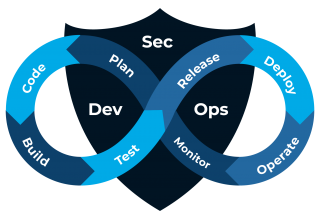In today’s rapidly evolving digital landscape, where security breaches and cyber threats are becoming increasingly common, the need for robust security practices within software development has become crucial. This is where DevSecOps, a groundbreaking approach to software development, comes into play. DevSecOps integrates security seamlessly into the software development lifecycle, fostering a culture of collaboration and responsibility among development, security, and operations teams.
The Basis of DevSecOps

DevSecOps, a combination of the terms “Development”, “Security”, and “Operations”, signifies a cultural shift in organizations’ approach to the design, development, and deployment of software. It is a subset of DevOps that focuses on integrating security practices into the development and operation process, ensuring that software is not only delivered quickly but also securely.
The need for integrating security into each phase of the development lifecycle is emphasized by DevSecOps. By utilizing a collaborative approach, security problems are promptly addressed, reducing the possibility of vulnerabilities and data breaches.
Core Principles of DevSecOps
Automation – With automation as its core objective, DevSecOps allows development teams to find vulnerabilities early in the development life cycle by automating security checks, testing, and compliance processes.
Shift Left Security – Security issues should be addressed at the earliest in the development process, according to the “shift left” idea. This method prevents security problems from building up and getting harder to fix later. When security is moved left, which is towards the start of the software development life cycle, every software build is secured and optimized for performance, cost, time-to-market, and other important business objectives. Through early security risk and exposure detection, the team will be able to safeguard every integration into the CI/CD pipeline.
Collaborative culture & communication – Development teams, security professionals, and operations teams should work together cross-functionally, according to DevSecOps. By encouraging knowledge exchange and enhancing understanding of security issues, this collaborative environment ultimately results in more dependable and secure software. Collaboration and communication are essential for ensuring that security specialists are involved right away and that development teams are aware of security best practices.
Continuous security testing – A continuous and iterative approach to software development is encouraged by DevSecOps. Code updates are routinely integrated, tested, and deployed using continuous integration (CI) and continuous deployment (CD). In addition to speeding up delivery, this quick iteration makes it possible to regularly validate and maintain security measures.
DevSecOps Tools

Static Application Security Testing (SAST) – In DevSecOps, SAST is a proactive security practice that involves analyzing source code, bytecode, or binary code to identify vulnerabilities early in the software development lifecycle. SAST tools scan codebase for potential security flaws, such as coding errors, insecure coding practices, and vulnerabilities. By integrating SAST into the development pipeline, teams can detect issues before they reach production, reducing the risk of exploits and data breaches.
Software Composition Analysis (SCA) – SCA is a crucial component of DevSecOps, which involves automatically scanning and analyzing third-party software components and libraries used in an application’s codebase. It helps identify vulnerabilities, outdated libraries, and license compliance issues early in the development process. By integrating SCA into DevSecOps pipelines, teams can proactively address security risks posed by open-source and third-party components, ensuring the overall security posture of the application.
Interactive Application Security Testing (IAST) – This is a vital component of DevSecOps that enhances security by dynamically analyzing applications as they run. Unlike traditional security testing methods, IAST identifies vulnerabilities in real-time during runtime, providing accurate insights into an application’s security posture. By integrating IAST into the development pipeline, DevSecOps teams can gain deeper visibility into application behavior and potential vulnerabilities, enabling faster identification and remediation of security issues.
Dynamic Application Security Testing (DAST) – This is a technique for automated opaque box testing that simulates how a hacker would interact with your website or application programming interface. It evaluates the client-side rendering of the program while testing it via a network connection. DAST focuses on the issues and security flaws in running applications by assuming real-world attacks.
Benefits of DevSecOps
Enhanced Security – By integrating security into all phases of development, vulnerabilities can be found and fixed at a faster pace, lowering the chance of data breaches and cyberattacks.
Faster Time-to-Market – Automation and continuous processes allow for more rapid development cycles and deployment, which speeds up the release of new software features and upgrades.
Cost-Effectiveness – Dealing with security concerns before a breach occurs is more cost-effective and saves time and resources.
Continuous Monitoring – DevSecOps ensures ongoing security monitoring and improvement, adapting to emerging threats and maintaining software integrity.
Collaborative Efficiency – DevSecOps improves collaboration by encouraging knowledge exchange among teams to solve problems more effectively.
Why is DevSecOps Important?
Networked, embedded, and IoT devices – DevSecOps enables programmers to create secure code that reduces the possibility of the CWE (Common Weakness Enumeration).
Healthcare – In health care, DevSecOps supports digital transformation initiatives while preserving the security and privacy of sensitive patient data following rules like HIPAA (Health Insurance Portability and Accountability Act).
Conclusion
DevSecOps is a revolutionary method for developing software in a time when cybersecurity threats are a constant worry, giving security priority without sacrificing agility and speed. Organizations may proactively manage risks, improve teamwork, and produce innivative software by integrating security into the development lifecycle. Accepting DevSecOps is not simply a technology change but a shift in culture to create reliable and dependable software for a safer digital future.





